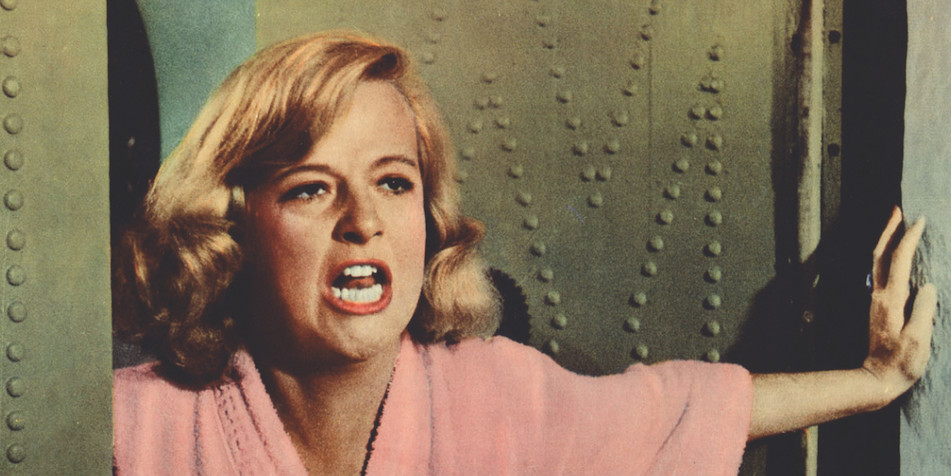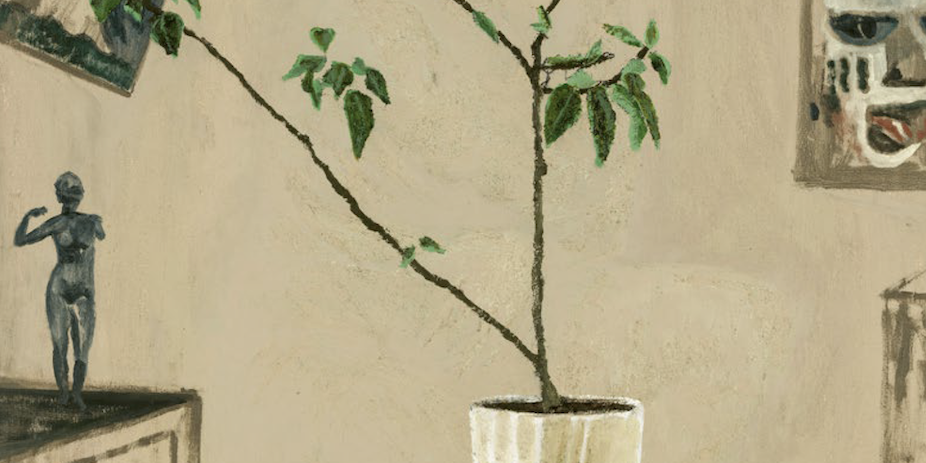ON JULY 18, 2009, to little fanfare, @ladygaga posted: “I love lee strasberg. he makes me miss school.” Sometimes Chekhov’s gun is a tweet, and this one finally went off more than a decade later when Gaga took on the role of jilted murderess Patrizia Reggiani in House of Gucci and stayed in character for nine months. The public didn’t hear about the firearm discharge until promotion of the film began. Gaga’s (self-)mythologizing press tour coincided with Michael Schulman’s New Yorker profile of Succession star Jeremy Strong, and those wildly disparate elements created a perfect storm of frenzy around “Method
- print • Mar/Apr/May 2022
- print • Mar/Apr/May 2022
Mamma Andersson, Artefakter med Fikus (Artifacts with Ficus), 2021, oil on canvas, 47 1/4 x 35 3/8″. Courtesy the artist and Galleri Magnus Karlsson, Stephen Friedman Gallery, and David Zwirner FROM CÉZANNE’S APPLES TO LOIS DODD’S CLOTHESLINES, the quotidian world, with its domestic scenes and unremarkable landscapes, has long inspired artists. Their scrupulously focused attention […]
- print • Mar/Apr/May 2022
KIDS TODAY! Is fashion all they care about? It’s a driving force on TikTok, and rare is the person under twenty-eight who doesn’t have something we’d call “style.” But the medium of fashion writing has left the kids tragically underfed. In fact, it’s left people of every age starving. It isn’t that no one is talking about it; teenagers on Twitter are practically building an archive of the 1990s-era work of the cerebral Belgian designer Martin Margiela and the provocateur Jean Paul Gaultier, and even your normie uncle has an opinion about whether men should wear skirts. It’s more like
- print • Mar/Apr/May 2022
THE STORY OF THE STETTHEIMER SISTERS is prestige TV waiting to happen—Jo March meets Hannah Horvath, set against the splendor of money, modernism, and early-twentieth-century Manhattan (with a summer estate or two thrown in for good measure). The eldest, blonde Carrie, was a consummate hostess who, in her spare time, meticulously crafted an opulent dollhouse. Ettie, the youngest, was a brooding Barnard grad with a temper and a unibrow, who, under her pseudonym “Henrie Waste,” once published a book titled Philosophy: An Autobiographical Fragment. And then there’s Florine, the hazy beauty in the middle, who styled herself as an acute observer,
- print • Mar/Apr/May 2022
IN COOKIE MUELLER’S 1984 BOOKLET How to Get Rid of Pimples, black-and-white photographs of the author’s pseudonymized friends are presented as befores, dotted with indelible marker, and afters. The diptychs are accompanied by semi-fictional, off-the-wall anecdotes about home remedies. On the cover, Mueller’s own face, photographed by David Armstrong, is stippled in black ink: just a before without an after.
- print • Mar/Apr/May 2022
IN AUGUST 1945, THREE MONTHS AFTER ADOLF HITLER’S SUICIDE in the bunker and the Allied victory in Europe, the Hollywood film director Billy Wilder arrived in Berlin. Wilder’s film Double Indemnity, that pinnacle of film noir, had come out the previous summer to great acclaim and box office success. The Lost Weekend, Wilder’s next film, equally dark and also a future classic, was being readied for fall release at Paramount. Now Wilder had been enlisted by the US Office of War Information to return to the city he’d fled in 1933, when he was forced out of screenwriting because he
- print • Mar/Apr/May 2022
IN 1998, Lucy Sante published The Factory of Facts, a memoir of her childhood in Belgium and the Sante family’s stuttering moves back and forth (and finally forth) to the States—ultimately, to Summit, New Jersey—when she was eight, in 1962. Toward the end of the memoir, she marks her story as a displacement, “as if I were writing about someone else.” Sante is talking, here, about the French of her youth contrasted with the English of America, and how “languages are not equivalent one to another.” Something else is in play, though. The eight-year-old boy that Sante speaks for would
- print • Mar/Apr/May 2022
EARLY ON, I WROTE A FACETIOUS POEM, a “Love-in-the-time-of-Corona” version of a Frank O’Hara classic and merrily posted it on Facebook. I know it began, “Having a Quarantine With You / is more fun than going to the supermarket or taking public transport,” but I can’t remember the rest because, not long after, I deleted it out of embarrassment. In a world where suddenly thousands were dying by the day, the vibe was seriously off. Much like the last squirt of Purell, whatever flimsy novelty the novel coronavirus offered evaporated pretty much instantaneously. If we were posting poetry, only elegies
- print • Mar/Apr/May 2022
TO TELL THE STORY of another person’s life poses certain challenges to an author wanting to capture their subject in the truest light possible. In the introduction to her ebullient, poignant What Is Now Known Was Once Only Imagined: An (Auto)biography of Niki de Saint Phalle, Nicole Rudick offers up her strategy for honest representation: “What could be closer to the artist’s voice than the artist’s own voice, closer to her sensibility than that produced by her own hand?” Rudick edited this hybrid volume of text and images, selecting and sequencing Saint Phalle’s own writings and works on paper to
- print • Mar/Apr/May 2022
Catalogue page featuring four Jens Risom pieces, 1952. © Jens Risom/FORM Archives IF FRENCH MODERNISM IS RATIONAL, Italian modernism sensual, German modernism ideological, and Danish modernism comfortable, what’s American modernism? I’d say it’s Danish. That’s because of Jens Risom, the Danish-born and -trained designer who, twenty-three years old on the eve of World War II, […]
- print • Mar/Apr/May 2022
THRALL IS A JEFFERSONIAN WORD. In Constructing a Nervous System, the critic Margo Jefferson is enthralled by or to: her mother, her father, Bing Crosby. She suspects Condoleezza Rice is enthralled by or to George W. Bush, and Ike Turner by or to “manic depression and drug addiction, to years of envy, . . . to a Mississippi childhood that was a trifecta of domestic abuse, sexual treachery and racist violence.” A young James Baldwin enthralled the Harlem faithful. Nina Simone refused the thrall of “warring desires.” It’s the last that clarifies the stakes. Thrall, some time after it meant
- print • Mar/Apr/May 2022
ONCE UPON A TIME, humans lived in small, nomadic, egalitarian bands of hunter-gatherers. Then, several thousand years ago, they domesticated plants and animals, discovered agriculture, and grew sedentary, eventually erecting cities, which gave rise to civilization—emperors, taxes, public works, the DMV. This was either a good thing (Hobbes) or a bad thing (Rousseau).
- print • Mar/Apr/May 2022
Jamal Cyrus, Untitled (Grand Verbalizer What Time Is It?), 2010, drum, leather, microphones, microphone stands, cables, speaker, dimensions variable. Courtesy the artist, Inman Gallery, Houston and Inventory Press/Collection of Ric Whitney & Tina Perr Houston native Jamal Cyrus calls his artistic mentor Terry Adkins a “cerebral artist with soul.” The same description could be applied […]
- print • Mar/Apr/May 2022
ZORA NEALE HURSTON’S LITERARY STATURE is no longer in dispute, yet people are still trying to put her into a box. “Do you think she was a libertarian?” someone once asked me. For whatever reason, I was too polite to say something like “How the hell should I know?” Far more polite than Hurston would be if she could now answer for herself. Yes, she made conservative, even reactionary noises in her lifetime against the NAACP, leftist politics, Richard Wright, and other socially progressive influences. But tagging Hurston as a libertarian or reactionary is far too reductive for such a
- review • March 1, 2022
Welcome to the Mar/Apr/May 2022 issue of Bookforum! In this edition, our contributors review new novels by Sheila Heti, Alejandro Zambra, Claire-Louise Bennett, and more, as well as newly reissued works by Kay Dick and Yūko Tsushima. The film critic A. S. Hamrah considers how director Billy Wilder bested the twentieth century, Sasha Frere-Jones reflects on essayist Lucy Sante’s inquisitive oeuvre, Harmony Holiday writes about the late hip-hop producer J Dilla’s poetics, and so much more. Read the issue online here, and consider signing up for or gifting a subscription.
- print • Mar/Apr/May 2022
ARTHUR JAFA RELAYS A HAUNTING INTERPRETATION of the griot as someone who cannibalizes the flesh of those whose stories he tells, as a matter of pragmatism, in order to keep those stories alive for the telling in himself. At the end of his life, the griot’s unsolicited efforts at preservation of both self and other are met with the same gesture: he is denied a traditional burial. His carrion is left out in the open air to be consumed by maggots, completing a loop or energy cycle in nature, which can be ruthlessly just and deliberate in its delivery of
- excerpt • February 3, 2022
About the time the playwright Lorraine Hansberry returned home to New York from Provincetown in the summer of 1957, a package arrived wrapped in plain brown paper. She had been waiting for it. Inside were copies of One: The Homosexual Magazine. One was sold mainly by subscription, because not many newsagents would have dared sell it, and even fewer people would have dared buy it. It was considered “obscene material” by the US Post Office; hence the nondescript wrapping.
- excerpt • January 27, 2022
During the mid-1970s, Hunter S. Thompson was a central figure at Rolling Stone magazine. Although he did not write about music, he was its most popular contributor, and Abe Peck observed his primacy at close range. After editing an underground newspaper in Chicago, Peck worked for Rolling Stone in the mid-1970s and later taught journalism at Northwestern University. In his estimation, Rolling Stone was one of the most important American magazines of its era, and Thompson defined its nonmusical voice during the 1970s. In particular, Thompson linked readers to their youthful iconoclasm even as their tastes changed. “He kept the
- excerpt • January 3, 2022
Eyes fixed on the Bulgarian editions of The Idiot (1869), Demons (1872), and The Brothers Karamazov (1880), my father advised me strongly against reading them: “Destructive, demonic, clinging, too much is too much, you won’t like him at all, let it go!” He dreamed of seeing me escape “the bowels of hell,” as he called our native Bulgaria, quoting some obscure verse in the Holy Scriptures. To fulfill this desperate plan, I only had to develop my “innate taste” for clarity and freedom, according to him, in French, of course, since he had introduced me to the language of La
- review • December 14, 2021
Greg Tate, a longtime contributor to the Village Voice and other publications, died last week. Here, four critics pay tribute to Tate’s influential, hyper-referential, bumptious, and generous writing and conversation.



















